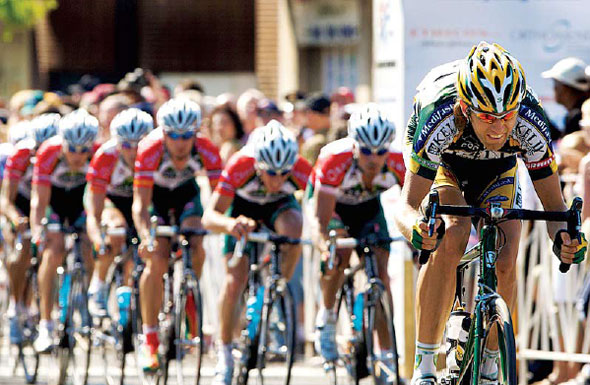Call of the bike
 |
| Photo courtesy of Circuit Global Sports Management |
As Reid Mumford pedals, sometimes he thinks about how to break away from the pack. Other times he thinks about how the smallest bits of the universe break apart in high-energy collisions.
Mumford, who studies rare subatomic particles at Fermilab, is a rarity himself: a particle physicist who is also a professional bicycle racer. Riding gives him a physical workout; analyzing data from the world's highest-energy particle accelerator, the Tevatron, exercises his mind.
"Cycling is a tough sport. You don't win much, but the one day that everything works is a beautiful thing," he says. "Just like high-energy physics research."
The 32-year-old finds a grueling physical trainer in the prairie-powered winds that sometimes threaten to topple strollers at the laboratory. On the most blustery days, wind speeds average 26 mph and gusts blow nearly 80 mph.
"The wind makes training here hard, which is a good thing," Mumford says. "Most of the people I race against live in high altitudes. If I didn't have the wind, it would be hard to get faster."
He practices 17 hours a week, even in the snow, using the time to recharge and work out complex theories in his head.
Mumford started racing as a graduate student at Johns Hopkins University. In 2007 he joined Kelly Benefit Stategies/ Medifast, a Minneapolis-based professional team. In a sport that requires half the team fall under age 27, Mumford had to work extra hard to secure a spot. After breaking his leg in a collision with a van during practice, he had to work even harder to recover and reclaim his position.
His Johns Hopkins professors and co-workers from the lab's CDF experiment support his bid for bicycling fame, helping him fit training—and weekend races all over the country—into grueling gradstudent hours of data analysis.
Mumford is wrapping up his PhD thesis and plans to take a break from physics in the fall to focus full-time on racing. But once that challenge runs its course, he hopes to return and tackle the new energy frontier at CERN's Large Hadron Collider.
You can find Mumford's team bio at www.symmetrymag. org/bikeracer/.
Tona Kunz
Click here to download the pdf version of this article.






